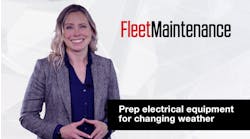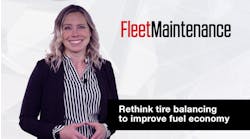When it comes to vehicle uptime, a critical aspect of expediting service for vehicles means utilizing mobile maintenance providers. Vanair’s Dean Strathman discusses the type of equipment necessary for mobile maintenance providers, what fleets should consider when purchasing this type of equipment for their own fleet, and assessing the capabilities of a contracted service provider.
Transcription of interview:
Erica Schueller, Fleet Maintenance: Welcome to VSP News: Uptime Update. I am your host Erica Schueller, editorial director of Fleet Maintenance magazine, covering all maintenance, all vehicle classes, all management, all the time.
While uptime seems like a buzzword we’ve all been hearing for the last several years, it truly encapsulates the focus of many fleets today. The focus of uptime is to ensure vehicles are operating to their full potential and running as much as possible. After all, if a truck isn’t on the road, a business isn’t making money.
When it comes to vehicle uptime, a critical aspect of expediting service for vehicles means utilizing mobile maintenance providers.
I sat down with Dean Strathman at Vanair to discuss the type of equipment necessary for mobile maintenance providers, and what fleets should consider when purchasing this type of equipment for their own fleet, or assessing the capabilities of a contracted service provider.
Dean Strathman, vice president of sales, Vanair Manufacturing: We’ve seen a pretty significant shift over the course of the last several years with the increase in needs of mobile maintenance market. What we see is that most of the customer base we’re dealing with is looking to be a total solution provider for that fleet.
Whether it be changing a tire, replacing marker lights, welding a mud flap bracket. Whatever it may be, we see customers driving toward products that give them the capability to do any of those tasks. There is a drive toward product that offers them the ability to maybe be able to weld, air for an air compressor or an air tool, electricity for electric tools, and certainly jump starting for any time there is a downed vehicle in the field.
Schueller, Fleet Maintenance: A dead battery means an inoperable vehicle. Strathman discusses the equipment considerations for mobile maintenance personnel when it comes to battery jump starts, especially as it relates to heavy duty commercial vehicles.
Strathman, Vanair: If you look at all of the OE chassis manufacturers today, there is a common theme in their branding and their marketing, and it speaks to customer uptime. When it comes to servicing the market and understanding what’s going on with dead batteries, you really have to know what your expectations are and who your clientele is (as a mobile maintenance provider).
Selecting the right product to address the dead battery situation might be “what size vehicle is it?” or it might be “how many vehicles are in the fleet?” There are a wide range of products on the market to address those issues.
Schueller, Fleet Maintenance: What is the difference between a starting/charging equipment and jump-starting equipment? Strathman provides details on the ideal applications for both product categories.
Strathman, Vanair: When we talk about the difference between a charging/starting piece of equipment, or a jump-starting piece of equipment, part of it is understanding what the need is. A lot of that is a time-based decision.
Some of it again goes back to the size of the vehicle, or the number of vehicles in the fleet, but if you have a lot of time and your desire is not to get that vehicle up and running quickly, you may opt for a less expensive piece of charging equipment that is going to – over a longer period of time – bring the battery back to an elevated (charge) state where it’s in a condition to start the vehicle.
As we talked about with uptime, most people don’t have that time and they don’t have that luxury. There have been lots of products that have been developed to address how to handle that in a more timely fashion.
There have been long-time products that have been out there. Our particular company, 78 years ago as part of the Goodall brand, had a start-all product that used generators to be able to aid in getting the batteries up to a specific charge level and assist the truck to be able to start.
In today’s world, there are hand-carry jump packs that are powerful enough that they can start a Class 8 truck in seconds. And they’re good for that application, if it’s the right conditions – not extreme cold, or not that many vehicles in the fleet. However, if you have a large fleet or extreme cold, there are also capacitor-based products out there, that are going to start trucks one after another, whether you have one vehicle in your fleet or 100 vehicles in your fleet.
Schueller, Fleet Maintenance: Strathman talks about future trends we might expect in the future, when it comes to heavy duty battery service and jump-starting equipment.
Strathman, Vanair: What we’ve seen is that there’s a significant trend to more and more mobile maintenance in general. In situations where someone may have taken a vehicle or a trailer out of service because of a specific issue, there is a huge emergence in the market with regard mobile maintenance. There are people now contracting with [mobile maintenance providers], and they’re coming on the lot after hours working on the trucks and trailers to make sure they reduce that downtime.
Uptime is the big word in the market. As we become a more mobile, or an “I need it now” environment, there is a need for all of these different products that we’re talking about, like an all-in-one power system or the right jump starting tool for your application it becomes more and more necessary, and it’s important for us to educate our customers on what they need.
Schueller, Fleet Maintenance: If you’re interested in reading more about battery service equipment for heavy duty vehicles, check out the link below.
That’s it for this week’s episode. Thank you for tuning in to VSP News Uptime Update, I’m your host Erica Schueller.
Until our next broadcast, keep up with this, and other industry topics, by visiting us online at VehicleServicePros.com.


